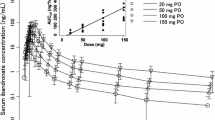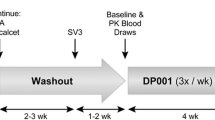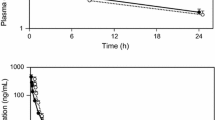Abstract
Objectives: A double-blind, placebo-controlled study was conducted to assess the pharmacokinetics and pharmacodynamics of the bisphosphonate tiludronic acid, administered once daily as sodium tiludronate 200, 400, 600 and 800 mg for 12 days. Four groups of ten subjects participated in the study, with a drug to placebo ratio of 4:1.
Methods:
Pre-dose blood samples were taken on alternate days, starting on Day 1 and additional samples were collected over 144 h following the final dose on Day 12. Urine was collected over 24 h after the final dose. Indices of calcium homeostasis and biochemical markers of bone turnover were assessed during the study as pharmacodynamic parameters. Tolerability was evaluated with special emphasis on renal function and gastrointestinal irritation. Adverse experiences were assessed at regular time intervals.
Results and conclusions:
Steady state was attained from Day 4 (200 mg) or from Day 6 (400, 600 and 800 mg). Following the final dose on Day 12, minimal plasma concentrations (Cmin) ranged between 0.19 and 1.5 mg ⋅ l−1, and maximal plasma concentrations (Cmax) between 1.1 and 7.8 mg⋅l−1 for the lowest and highest doses, respectively. A supra-proportional increase in Cmax, AUC24 and Ae 24 with dose was observed. There was a linear relationship between the plasma tiludronic acid and its urinary excretion rate, so, the disproportional rise in Cmax and AUC24 with increasing dose could not be attributed to saturation of renal excretion.
Certain indices of calcium homeostasis changed significantly during the study, but generally, became only prominent at the highest dose level of 800 mg. Total serum calcium and the urinary calcium/creatinine clearance ratio fell, indicating depression of osteoclastic bone resorption, which was not revealed by serum osteocalcin levels probably because of the brevity of the treatment (12 days). In response to the decline in serum calcium, serum 1,25-dihydroxyvitamin D3 and intact PTH (1–84) levels increased.
None of the safety parameters raised any concerns about the safety of sodium tiludronate administered in this way.
Similar content being viewed by others
Author information
Authors and Affiliations
Additional information
Received: 11 September 1995/Accepted in revised form: 28 March 1996
Rights and permissions
About this article
Cite this article
Schwietert, H., Peeters, P., Dingemanse, J. et al. Multiple dose pharmacokinetics of tiludronate in healthy volunteers. E J Clin Pharmacol 51, 175–181 (1996). https://doi.org/10.1007/s002280050181
Issue Date:
DOI: https://doi.org/10.1007/s002280050181




